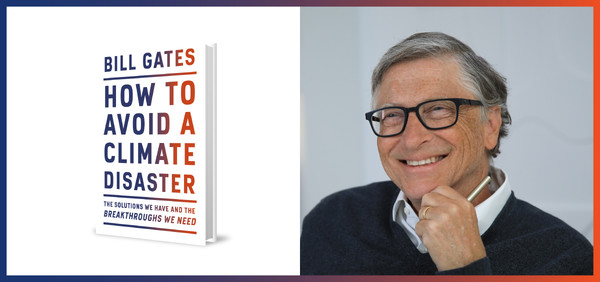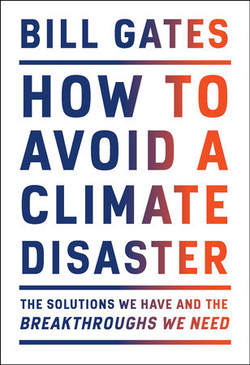Gates' roadmap to a sustainable future

"I AM aware I am an imperfect messenger on climate change. The world is not exactly lacking in rich men with big ideas about what others should do," acknowledges Bill Gates in his newest book, How to Avoid a Climate Disaster: The Solutions We Have and the Breakthroughs We Need. Gates directly addressed the question that came to mind when I first saw his book: "Why should we take time and listen to this older, privileged man?" Gates spent the last ten years researching, investing, and finding ways technology can eliminate carbon emissions. From his research, Gates concludes carbon neutrality is the only way to avoid climate catastrophe, and developed nations need to reach it by 2050.
Gate's take on Climate Change
For Gates, the shift to net-zero emissions does not mean a drastic shift in the average person's lifestyle. However, reaching carbon neutrality without radically changing our everyday life is a foolishly optimistic thought. For one, fossil fuels result from both the production and transportation of nearly everything. For a good reason too: fossil fuels are cheap and reliable. To address our current bind, Gates emphasizes that the key to achieving net-zero emissions is to make clean energy as reliable and cheap as fossil fuels.
The goal of net-zero emissions seems to be rising in urgency on the world's agenda. More than 110 countries, including South Korea, have pledged carbon neutrality by 2050 and to reach the Paris Agreement target by 2030[1]. However, Gates disagrees with 2030 as a target: "2030 is not realistic." He writes, "Making reductions by 2030 the wrong way might actually prevent us from ever getting to zero." Though Gates disagrees with 2030 as a target date, he failed to detail how the earlier objective would be counterproductive. His lack of explanation ultimately casts doubts on his argument, especially when 2030 is broadly seen as the necessary target. Son Sung-hwan (Prof., UIC, Sustainable Development and Cooperation & Chairperson of WWF Korea) sees the value in keeping both 2030 and 2050's objectives, "I do not think the concepts are contradictory," Professor Son says, "2030 is a needed milestone. It gives us the direction to see if we can achieve neutrality by 2050."
Gates describes the next ten years as a crucial period to invest and innovate green technologies. To eliminate carbon emissions, Gates emphasizes the need to shift to green alternatives by eliminating green-premiums. As described by Gates, green-premiums are the cost differences between actions that produce and the similar more eco-friendly actions that do not produce greenhouse gases. Governments provide subsidies to eliminate green-premiums and help renewable energy compete against carbon-emitting sources, like carbon-based factories. Green premiums are a tool to highlight the areas that need the most "innovation," "investment," and "subsidies," which are keywords that Gates constantly stresses to achieve carbon neutrality.
What should we do?
South Korea declared its intentions to achieve carbon neutrality by 2050, but because it is the 7th largest carbon emitter globally, this goal seems a bit far-fetched. The goal for South Korea is to move forward with carbon-free electricity and decarbonization. Electricity is one of the five areas Gates outlines possible solutions to reach net-zero emissions.
Gates sees electricity as the starting point: once we decarbonize electricity, all the areas will see some percentage of their carbon emissions drop. Decarbonizing proves to be difficult, since certain intermittent net-zero energy sources, like solar and turbines, lack reliability. As a reliable source of energy, Gates endorses nuclear to be a possible solution. To which Professor Son comments that "[Gates] is right, without counting nuclear energy into the equation, it will be very difficult to reach carbon neutrality for any country, […] but we need to allow the technology to develop to make it safer, small scale and manageable." Shifting electricity might seem like a daunting task, but it seems by far one of the easiest areas to achieve carbon neutrality.
Manufacturing and agriculture are among the most challenging categories to eliminate emissions as there are not enough innovations or incentives to invest. Manufacturing is a whopping 31% of the world's carbon emissions and we have yet to develop a feasible approach on this front. As for most areas, Gates proposes to "electrify" all parts of the industry, use carbon capture[2] for the carbon that will inevitably be produced, and use materials more efficiently.
In his chapter on agriculture, Gates focuses on fertilizer and deforestations rather than solutions for the meat industry. Though agriculture accounts for around 19% of the world's carbon emissions, it still does not have viable solutions. One of the obstacles that Gates addresses is that there is no way to accurately calculate a green-premium for fertilizers since there is no way to capture nitrous oxide. Without having a green-premium to guide subsidies, the only solution Gate gives is, once again, vague calls of action for innovation followed by heavy investment. Gates also briefly touches on deforestation, and concludes that despite incentives to replant, the most cost-effective solution is to stop cutting down trees—what a "groundbreaking discovery." Gates is not the only one that has low hopes for changes within the agriculture industry. In South Korea, instead of a shift in consumer diets, reforestation is a more realistic solution to reduce agriculture’s carbon emissions.

Who is this book for?
While Gates lists the possible solutions for each category, it is difficult to see where the reader fits into the discussion. Each chapter has the same conclusion: innovation and investment. While these solutions are valid, they seem to give the readers an "out" from the responsibility of combating climate change. Without the means or incentive to neither invest nor innovate, the reader feels helpless. Outside the occasional "consume less" comment, Gates fails to mention how we can help until the few last chapters of the book, where he faintly brushes on our power as voters and consumers.
Which leads to the question: "Who is this book for?" While not so self-evident, the answer is still us. While the book informs us of the stakes and the rising technology related to carbon neutrality, it is not trying to get us to invest in these technologies ourselves. Rather, through our power of purchase, citizens can direct the market in that direction. The best way to help achieve net-zero for the average consumer is to choose the right products to encourage the industry to produce more sustainably.
Our role is also to elect environmentally conscious people into office. Gates does not delve too much into climate change politics, despite how dependent his solutions are to specific policy changes. However, to promote change in governments' stances towards climate change, Professor Son emphasizes that the electors need to show their support to candidates who have carbon reduction in mind. In recent years, Green parties have been given a more prominent voice through elections, and that trend needs to be encouraged further. As Professor Son puts it, "If we combine the efforts of the whole of government and the whole of society, [we might] achieve carbon neutrality."
* * *
With a climate catastrophe upon us, How to Avoid a Climate Disaster aims to educate readers on the realities, challenges, and plausible solutions for carbon emission neutrality. Gates gives his readers digestible information on how to achieve zero-emissions, but do not expect tips and tricks to reduce your emissions. Gates draws the bigger picture of climate change, but it is now our turn to fill in the gaps.
[1] United Nations News
[2] Carbon Capture: Process that captures and reuses/stores carbon dioxide emissions

